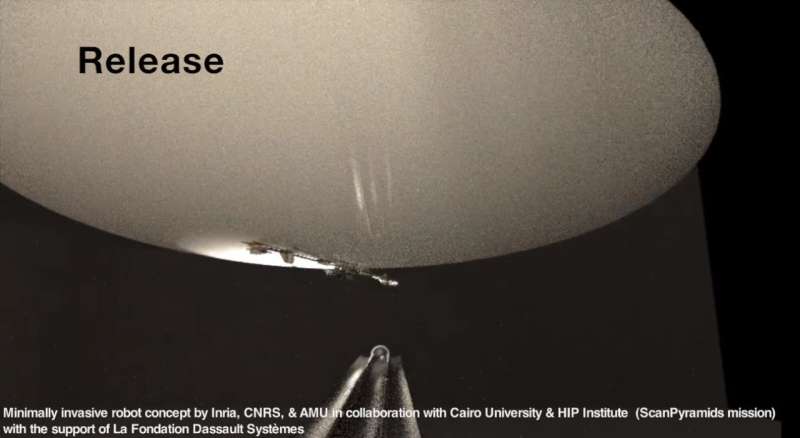December 14, 2017 weblog
Exploring blimp could tell us about hidden worlds

(Tech Xplore)—Mission: To design an innovative robot that can explore heritage buildings while leaving as few traces as possible.
That is the assignment being taken by scientists in a collaborative effort which draws talents from Inria and CNRS joining hands with the Faculty of Engineering of Cairo University and the HIP Institute (Heritage, Preservation, Innovation)—along with support of the Robeauté company and La Fondation Dassault Systèmes.
Scientists call this approach "minimally invasive robotic exploration." Its tasks, said New Atlas, would be to "explore the hidden world, mapping the layout, collecting data and snapping photos or video without causing damage to the fragile building or monument."
And this collaborative resolve brings us to the ScanPyramids project, which has become a key area of focus, in news about this robot platform. How were the pyramids built?
IEEE Spectrum's headline on Tuesday was "Robotic Blimp Could Explore Hidden Chambers of Great Pyramid of Giza."
IEEE Spectrum's Evan Ackerman said Tuesday: "French research institutes Inria and CNRS are working with ScanPyramids to develop an exploration robot that can squeeze through a tiny hole while still maximizing the amount of exploration that it can do once it's through."
Jean-Baptiste Mouret, a senior researcher is leading the team developing the system. In an interview with IEEE Spectrum, he talked about how the robot could play a role in the ScanPyramids mission.
Mouret in fact thinks the most exciting place to first deploy this robot would be the Great Pyramid, as the ScanPyramids mission, he said, "recently discovered at least three important voids using cosmic-ray muon detectors: A big void above the Grand Gallery, the start of a corridor on the North face, and a smaller void on the North-East edge."
Mouret and team joined the ScanPyramids team to be ready if there was an opportunity.
Even though there was no concrete plan to send this robot in any particular monument, Mouret said it was the right time "to imagine, develop and validate the technologies that are needed to explore heritage buildings."
So what would be the technical challenges for this platform? A video shows inflation, docking, deflation. At the end of its mission, the blimp would return to a docking station and deflate itself for retrieval through the hole, said New Atlas.
Actually, the exploration involves two stages; A tubular robot with a camera is inserted and takes pictures. Second, the same hole is used to send an explorer robot, operated remotely, traveling through corridors and helping to map the interior. This is where the little blimp plays its role.
Ackerman wrote about the miniature blimp insertion in more detail.
"If everything looks appropriately safe and exciting, the same hole gets used to insert a folded-up miniature robotic blimp. Once inside, the blimp is inflated with helium and unfolds to a diameter of 80 cm. It then undocks and floats off with a 50-gram payload of motors and sensors, including lights, cameras, and assistive navigation systems."
Paul Ridden, New Atlas, described "a self-inflating, sensor-packed blimp."
The flying blimp is untethered. In an interview, Mouret said small flying blimps cannot carry a tether because this would weigh too much (even a light wire), add friction because of the part of the wire on the floor and disturb the flight. They are using "lightweight bio-mimetic sensors," he said, to design a virtual tether. The robot needs to be able to come back autonomously even if it loses the radio connection and it needs to dock more or less autonomously.
© 2017 Tech Xplore




















